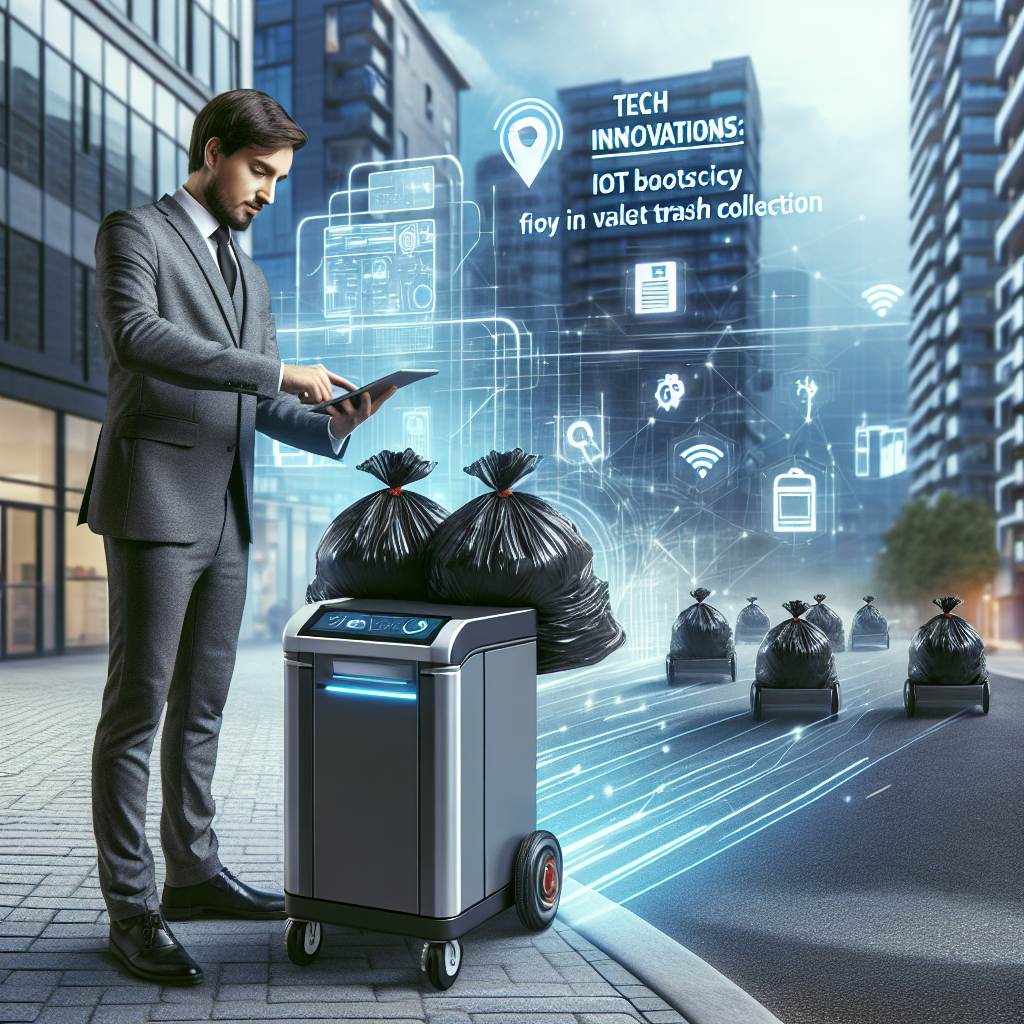Discover how IoT is revolutionizing valet trash collection by enhancing efficiency and streamlining operations. Embrace the future of waste management and optimize your services today! Learn more.
Revolutionizing Valet Trash Collection: How IoT in Waste Management Drives Efficiency Improvements
The integration of the Internet of Things (IoT) into various sectors has been transformative, and the waste management industry is no exception. Specifically, valet trash collection services, which have become increasingly popular in residential communities, are experiencing significant enhancements in efficiency due to IoT technologies. By leveraging IoT, these services are not only optimizing their operations but also contributing to a more sustainable environment.
To begin with, IoT devices are revolutionizing the way valet trash collection services monitor waste levels. Traditionally, waste collection schedules were based on fixed intervals, often leading to inefficiencies such as collecting bins that are not full or missing those that are overflowing. However, with the advent of IoT-enabled sensors, waste bins can now communicate their fill levels in real-time. These sensors, strategically placed in trash receptacles, provide data that allows service providers to adjust their collection schedules dynamically. Consequently, this leads to a more efficient allocation of resources, reducing unnecessary trips and optimizing fuel consumption.
Moreover, IoT technology facilitates enhanced route optimization for valet trash collection services. By analyzing data from GPS devices and real-time traffic updates, IoT systems can determine the most efficient routes for collection vehicles. This not only minimizes travel time and fuel usage but also reduces the carbon footprint of the operations. As a result, service providers can achieve significant cost savings while contributing to environmental sustainability. Additionally, the ability to adapt routes in real-time ensures that any unforeseen obstacles, such as road closures or traffic congestion, can be swiftly navigated, further enhancing operational efficiency.
In addition to optimizing collection schedules and routes, IoT is also playing a crucial role in predictive maintenance of waste collection vehicles. IoT sensors can monitor various parameters of the vehicles, such as engine performance, tire pressure, and brake conditions. By analyzing this data, potential issues can be identified before they lead to breakdowns, thereby reducing downtime and maintenance costs. This proactive approach not only ensures that the fleet remains in optimal condition but also enhances the reliability of the service provided to residents.
Furthermore, IoT technology is enabling better communication and transparency between valet trash collection services and their clients. Through mobile applications and online platforms, residents can receive notifications about collection times, report issues, and provide feedback. This increased level of interaction fosters a sense of community involvement and satisfaction, as residents are kept informed and can actively participate in the waste management process. Additionally, the data collected through these platforms can be analyzed to identify trends and areas for improvement, allowing service providers to continually refine their operations.
In conclusion, the integration of IoT into valet trash collection services is driving significant efficiency improvements across various aspects of the operation. From real-time monitoring of waste levels and route optimization to predictive vehicle maintenance and enhanced communication with clients, IoT is transforming the way these services are delivered. As the technology continues to evolve, it is likely that even more innovative solutions will emerge, further enhancing the efficiency and sustainability of valet trash collection. Ultimately, the adoption of IoT in waste management not only benefits service providers and residents but also contributes to a cleaner and more sustainable environment for all.
Smart Waste Tracking and Digital Trash Solutions: The Role of IoT in Enhancing Valet Trash Collection
The integration of the Internet of Things (IoT) into various sectors has revolutionized traditional practices, and the waste management industry is no exception. Specifically, valet trash collection services, which have become increasingly popular in residential communities, are experiencing significant enhancements in efficiency and effectiveness through the adoption of IoT technologies. By leveraging smart waste tracking and digital trash solutions, IoT is transforming how valet trash collection is managed, leading to improved service delivery and resource optimization.
To begin with, IoT devices enable real-time monitoring of waste levels in trash bins, which is a crucial aspect of enhancing valet trash collection. Sensors installed in bins can detect the fill level and send data to a centralized system. This information allows service providers to optimize collection schedules, ensuring that bins are emptied only when necessary. Consequently, this reduces unnecessary trips, saving time and fuel, and ultimately lowering operational costs. Moreover, by preventing overflow situations, IoT solutions contribute to maintaining cleanliness and hygiene in residential areas, enhancing the overall living experience for residents.
In addition to optimizing collection schedules, IoT facilitates better route planning for valet trash collection services. By analyzing data from multiple sources, including traffic patterns and bin fill levels, IoT systems can generate the most efficient routes for collection vehicles. This not only minimizes travel time and fuel consumption but also reduces the carbon footprint of waste collection operations. As a result, service providers can offer more sustainable and environmentally friendly solutions, aligning with the growing demand for green practices in waste management.
Furthermore, IoT technologies enable enhanced communication and transparency between service providers and residents. Through mobile applications and online platforms, residents can receive notifications about collection schedules, report issues, and provide feedback. This two-way communication fosters a sense of community involvement and ensures that service providers can promptly address any concerns. Additionally, the data collected through IoT devices can be used to generate detailed reports and analytics, offering valuable insights into waste generation patterns and helping communities make informed decisions about waste management strategies.
Another significant advantage of IoT in valet trash collection is the potential for predictive maintenance of waste collection equipment. By continuously monitoring the condition of vehicles and equipment, IoT systems can predict when maintenance is required, preventing unexpected breakdowns and ensuring uninterrupted service. This proactive approach to maintenance not only extends the lifespan of equipment but also enhances the reliability of valet trash collection services.
Moreover, the integration of IoT in valet trash collection aligns with the broader trend of smart city development. As urban areas continue to grow, the demand for efficient and sustainable waste management solutions becomes increasingly critical. IoT technologies provide the tools necessary to meet these demands, offering scalable solutions that can be adapted to the unique needs of different communities. By embracing IoT, valet trash collection services can contribute to the creation of smarter, more sustainable cities.
In conclusion, the role of IoT in enhancing valet trash collection is multifaceted, offering numerous benefits that improve efficiency, sustainability, and customer satisfaction. Through smart waste tracking, optimized route planning, enhanced communication, predictive maintenance, and alignment with smart city initiatives, IoT is transforming the landscape of waste management. As technology continues to evolve, the potential for further innovations in valet trash collection remains vast, promising even greater advancements in the future.
Automation and Tech Innovations: Transforming Valet Trash Collection with IoT for Optimal Efficiency
The integration of the Internet of Things (IoT) into various industries has revolutionized traditional practices, and valet trash collection is no exception. This service, which involves the scheduled collection of waste from residents’ doorsteps in multi-family housing complexes, has seen significant improvements in efficiency and effectiveness through the adoption of IoT technologies. By leveraging IoT, valet trash collection companies can optimize their operations, reduce costs, and enhance customer satisfaction.
To begin with, IoT devices enable real-time monitoring and data collection, which are crucial for optimizing waste collection routes. Sensors placed in trash bins can detect the fill level and communicate this information to a central system. This data allows waste management companies to plan collection routes more efficiently, ensuring that only full bins are collected. Consequently, this reduces unnecessary trips, saving time and fuel, and ultimately lowering the carbon footprint of the operation. Moreover, by avoiding the collection of empty or nearly empty bins, companies can allocate their resources more effectively, focusing on areas with higher demand.
In addition to route optimization, IoT technology facilitates predictive maintenance of equipment used in valet trash collection. Sensors can monitor the condition of collection vehicles and other machinery, providing alerts when maintenance is required. This proactive approach helps prevent unexpected breakdowns, which can disrupt service and lead to increased operational costs. By maintaining equipment in optimal condition, companies can ensure a more reliable service, enhancing customer satisfaction and trust.
Furthermore, IoT enhances communication between service providers and residents. Through mobile applications and smart devices, residents can receive notifications about collection schedules, changes in service, or any issues that may arise. This transparency fosters a better relationship between the service provider and the community, as residents are kept informed and can plan accordingly. Additionally, residents can use these platforms to report issues or provide feedback, allowing companies to address concerns promptly and improve their services.
Another significant advantage of IoT in valet trash collection is the ability to gather and analyze data for strategic decision-making. By collecting data on waste generation patterns, companies can identify trends and adjust their services to meet the evolving needs of the community. For instance, if data indicates an increase in waste production during certain times of the year, companies can allocate additional resources to manage the increased demand. This data-driven approach not only improves operational efficiency but also contributes to more sustainable waste management practices.
Moreover, IoT can play a role in enhancing safety for both workers and residents. Sensors and cameras can be used to monitor collection areas, ensuring that operations are conducted safely and efficiently. In the event of an incident, such as a spill or obstruction, the system can alert workers to address the issue promptly, minimizing potential hazards. This focus on safety not only protects workers but also ensures a cleaner and safer environment for residents.
In conclusion, the integration of IoT into valet trash collection has brought about significant improvements in efficiency, cost-effectiveness, and customer satisfaction. By enabling real-time monitoring, predictive maintenance, enhanced communication, data-driven decision-making, and improved safety, IoT technologies are transforming the way valet trash services are delivered. As the industry continues to evolve, the adoption of IoT will undoubtedly play a crucial role in shaping the future of waste management, paving the way for smarter, more sustainable practices.



